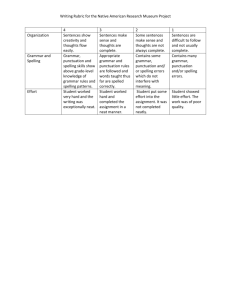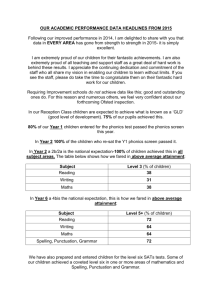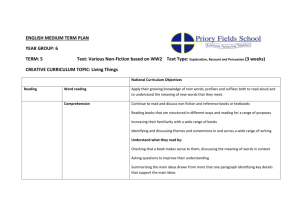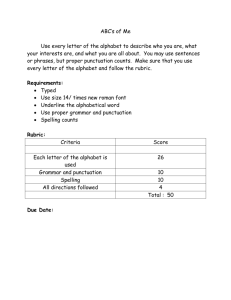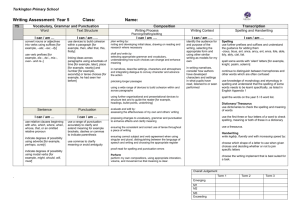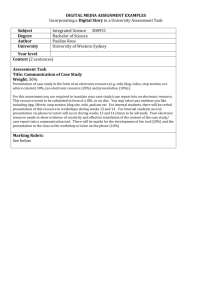School Plan 2012
advertisement
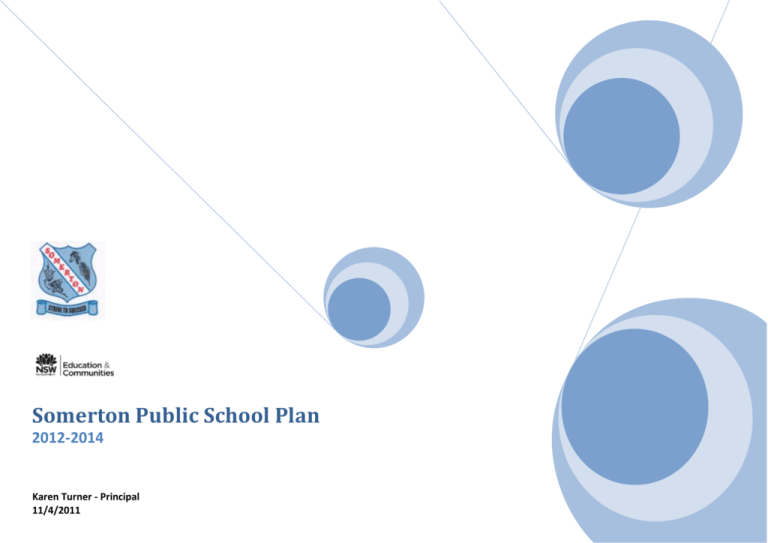
Somerton Public School Plan 2012-2014 Karen Turner - Principal 11/4/2011 SOMERTON PUBLIC SCHOOL PLAN 2012 -2014 SCHOOL CONTEXT Somerton Public School is a picturesque rural school situated forty kilometres west of Tamworth on the Oxley Highway. The school provides a happy, safe and caring environment where students are valued and gain a sense of belonging and common purpose. The students have a strong community spirit and are proud of their school. Somerton Public School has been operating for over 125 years, with student numbers varying between 13 and 48 students over the last 20 years. There are currently 16 students enrolled from 12 families. Four of our students identify as Aboriginal and there are no students from a non English speaking background. We have two multi-stage classes for literacy and numeracy and students are combined three afternoons a week for CAPA, PDHPE, Library and Assemblies. The lower division class is currently made up of 8 students from Kindergarten to Year Two, while the upper division class has 8 students from Year Three to Year Six. Both classes feature explicit and systematic teaching to enable students to access appropriate learning outcomes; and individual learning plans to maximise instruction in literacy and numeracy. The school is supported by an active and committed parent body which raises funds to provide us with resources and financial assistance. This enables us to offer a wide range of programs and activities for our students, helping us to promote their physical, social and emotional wellbeing. The school plays a very important role in the life of the village. It participates in a number of community events throughout the year. Parents and members of the community make valuable contributions to the school’s programs and the welfare of the students. They help with activities such as subsidising major excursions, assisting in the classrooms, providing transport to sporting and cultural events and subsidising the intensive swimming scheme. At the beginning of 2011 the school was reclassified from a P5 to a P6 and we lost our second classroom teacher, causing a lot of anxiety in the community. As a result a number of families have enrolled their children in larger schools in either Tamworth or Gunnedah, further reducing our numbers. SCHOOL IDENTIFIED PRIORITY AREA/S INTENDED OUTCOME/S Literacy Improve the literacy of all students with a focus on spelling, grammar and punctuation. Numeracy Improve the numeracy skills of all students with a focus on working mathematically to solve problems. PRINCIPAL’S SIGNATURE SCHOOL IDENTIFIED PRIORITY - LITERACY SED ENDORSEMENT DATE Improve student writing by improving their grammar and punctuation skills. Increase teacher knowledge of the teaching of spelling, grammar and punctuation. TARGET/S OUTCOME/S Improve the spelling skills of all students Teachers undertake training in the use of data (including Best Start and SMART) to inform planning for teaching and learning. INDICATORS Train principal, teacher & SLSO in the teaching of grammar and punctuation through literature, and in understanding student achievement standards to align with implementation of the National Curriculum in 2013. STRATEGIES Increase the school average percentage of year 3 students in bands 5 & 6 for spelling by 10% in 2010-2012 compared to 2008-2010. Increase the school average percentage of year 3 students in band 6 for grammar & punctuation by 10% in 2010-2012 compared to 2008-2010. Improve the average progress in spelling for year 5 students by 10 points in 2010-2012 compared to 2008-2010. Improve the average progress in grammar and punctuation for year 5 students by 10 points in 2010-2012 compared to 2008-2010. TIMEFRAME 2012 2013 2014 RESPONSIBILITY Reform Training undertaken with SDO during Term 1, 2012. Teaching and learning programs developed with explicit reference to areas identified through NAPLAN data analysis and school’s assessment of student achievement. Assessment online tool used as additional pre/post measure for tracking progress and achievement in Feb/Mar and again in Oct/Nov. Plan Implement Consolidate Imbed Principal 4 1 2 Principal, teacher & SLSO attend region-based training. Teacher knowledge of the teaching of spelling, grammar & punctuation and their specific demands in Years 3-6 increase. Teachers are aware of an increased range of strategies and resources to support the teaching of spelling, grammar & punctuation. Training & Implem enting Consoli dating Imbed Principal Teacher SLSO 4 2 1 FUNDING SOURCE/BUDGET 2012 Nil $600 Low SES $500 TPL Purchase spelling, grammar & punctuation resources as needed. Employ SLSO to support classroom practice in the school’s multi stage context. Principal 3 4 $495 Low SES $500 Global Budget Teachers are supported when implementing teaching and learning programs across stages. Staff collegiality and professional discussion about students learning. A range of teaching ideas and ‘walls that teach’ are evident in classrooms. All Aboriginal and at risk students have a Personalised Learning Plan. Parents and caregivers are involved in the development of PLPs. Classroom and state assessment information is analysed and used to inform PLPs. Students are provided with support to improve their learning outcomes. Principal 3 5 6 $15785 Low SES Principal Teacher SLSO 4 5 6 Nil The community knowledge of writing and how to support children’s spelling, grammar & punctuation increases. Parents report that they are more confident in supporting their children’s writing. Principal Teacher SLSO 6 $100 Global Budget Ensure all Aboriginal students and students at risk have a Personalised Learning Plan which is developed with parents and/or caregivers and is updated each term. Identify target students in need of support from the SLSO. Provide parent/carer workshops in spelling, grammar and punctuation to raise their knowledge of expected outcomes for students in writing and how to support student writing at home. Student writing improves as a result of improved spelling, grammar & punctuation. Teachers have access to and make use of a range of materials to teach spelling, grammar & punctuation. Students are spelling and punctuating increasingly complex words and sentences correctly. SCHOOL IDENTIFIED PRIORITY - NUMERACY Improve student ability to work mathematically and problem solve. Increase teacher knowledge of the teaching of problem solving strategies. TARGET/S OUTCOME/S Improve the numeracy skills of all students STRATEGIES Teachers undertake training in the use of data (including Best Start and SMART) to inform planning for teaching and learning. Train principal, teacher & SLSO in the teaching of problem solving using NEALS Analysis strategies, and in understanding student achievement standards to align with implementation of the National Curriculum in 2013. INDICATORS Increase the school average percentage of year 3 students in band 6 for numeracy by 10% in 2010-2012 compared to 2008-2010. Increase the school average percentage of year 5 students in band 8 for numeracy by 10% in 2010-2012 compared to 2008-2010. Improve the average progress in numeracy for year 5 students by 10 points in 2010-2012 compared to 2008-2010. Training undertaken with SDO during Term 1, 2012. Teaching and learning programs developed with explicit reference to areas identified through NAPLAN data analysis and school’s assessment of student achievement. Assessment online tool used as additional pre/post measure for tracking progress and achievement in Feb/Mar and again in Oct/Nov. Principal, teacher & SLSO attend region-based training. Teacher knowledge of the teaching of problem solving strategies in Years 3-6 increases. Teachers are aware of an increased range of resources to support the teaching of working mathematically and problem solving. TIMEFRAME RESPONSIBILITY Reform 2012 2013 2014 Plan Implement Consolidate Imbed Principal 4 1 2 Training & Implem enting Consoli dating Imbed Principal Teacher SLSO 4 2 1 FUNDING SOURCE/BUDGET 2012 Nil $600 Low SES $500 TPL Purchase working mathematically and problem solving resources as needed. Employ SLSO to support classroom practice in the school’s multi stage context. Ensure all Aboriginal students and students at risk have a Personalised Learning Plan which is developed with parents and/or caregivers and is updated each term. Identify target students in need of support from the SLSO. Provide parent/carer workshops in Mathematics to raise their knowledge of expected outcomes for students and how to support students at home in Mathematics. Teachers have access to and make use of a range of materials to teach problem solving and working mathematically. Students are solving increasingly complex mathematical problems correctly. Student’s numeracy results improve as a result of improved problem solving skills. Teachers are supported when implementing teaching and learning programs across stages. Staff collegiality and professional discussion about students learning. Student work samples are used as a basis for staff professional dialogue. All Aboriginal and at risk students have a Personalised Learning Plan. Parents and caregivers are involved in the development of PLPs. Classroom and state assessment information is analysed and used to inform PLPs. Students are provided with support to improve their learning outcomes. The community knowledge of numeracy and how to support children at home increases. Parents report that they are more confident in supporting their children in Mathematics. Principal 3 4 $500 Low SES Principal 3 5 6 $13842 Low SES Principal Teacher SLSO 4 5 6 Nil Principal Teacher SLSO 6 $100 Global Budget
